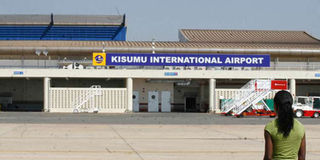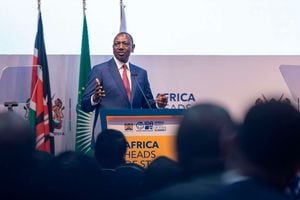Kisumu airport yet to benefit from Sh3.3bn facelift

A view of a section of Kisumu International Airport. PHOTO | TOM OTIENO | NATION MEDIA GROUP
What you need to know:
- The Kisumu International Airport (KIA) continues to be mainly dominated by local scheduled flight affiliated to Kenya Airways Ltd, and Fly540 Kenya, which fly the Kisumu-Nairobi route.
- The business community in Kisumu and western region, say this scenario has seriously disorganized them as many ventured into the lakeside town in anticipation that they will be able to cash in on the expected large number of international arrivals.
- The Kenya Airways CEO clarifies that infrastructure by its very nature starts to attract traffic, and then over time, that traffic then demands that an international flight be started.
Almost four years since the Kisumu airport was upgraded to international standards, not a single scheduled passenger flight has used it for direct international travel.
Traders who had set up businesses in the lakeside town hoping to cash in on international flights are now frustrated.
The facility is dominated by domestic operators flying from Nairobi, although it has received non-scheduled craft from countries such as South Africa, Seychelles, Nigeria, Europe, France, Italy and Sweden.
Transport Cabinet Secretary James Macharia says the airport has the facilities and services (Immigration, Port-health and Customs) to handle international flights.
“As the demand for such services improves, coupled with an ongoing facelift, we expect to have regular international flights,” says Mr Macharia.
He says the airport is being improved to handle larger aircraft. The upgrade includes strengthening of the runway and expansion of its shoulders. It is scheduled for completion in June, 2017, at a cost of about Sh600 million.
Mr Macharia says cargo facilities are run on a concession basis, with Trans Global Ltd being awaited to develop transit sheds and warehouses. The capacity will be determined by business volumes, he says.
The Kisumu International Airport (KIA) continues to be mainly dominated by local scheduled flight affiliated to Kenya Airways Ltd, and Fly540 Kenya, which fly the Kisumu-Nairobi route.
The business community in Kisumu and western region, say this scenario has seriously disorganized them as many ventured into the lakeside town in anticipation that they will be able to cash in on the expected large number of international arrivals.
The Sh3.3 billion upgrade of Kisumu airport to international standards which started in October 2008 involved the extension of the runway, and widening its width to enable it accommodate larger aircrafts. There was also the construction of taxi way, apron and a new terminal that can now hold upto 600 people per hour.
Mr Robinson Anyal, chairman Western Kenya Hospitality Leaders Association, says there are investors who set up businesses in the western Kenya region, with the KIA being the main factor, and its delayed use internationally, has hit their businesses hard.
“We had expected that the larger aircrafts will start landing immediately after the expansion to international status,” Mr Anyal said.
The upgraded KIA was officially opened in February, 2012 by President Mwai Kibaki and Prime Minister Raila Odinga.
Mr Vinod Patel, former Federation of Kenya Employers (FKE) western Kenya chairman says that the fishing industry in Lake Victoria is on its knees as Kenya imports fish from China. He says that opening up KIA to the international world will create market for local fish.
Further, flower grown in Nandi and Kericho areas, can be processed and packaged in Kisumu and then exported to Netherlands among others, through the KIA.
Currently, the flowers are being transported to Nairobi for export through Jomo Kenyatta International Airport (JKIA).
However, National carrier — Kenya Airways — chief executive Mbuvi Ngunze says, airlines will always consider the level of direct traffic between an airport and another international destination, before international flights can commence.
“Air transport is an investment and a firm in that business like Kenya Airways, will always be looking at, where is the fine balance between the traffic that is originating from a place to where it is going,” said Mr Ngunze.
Mombasa for instance, has seasonal air traffic. Kenya Airways has done flights for example, Nairobi, Mombasa, Jeddah (a city in Saudi Arabia), because of the Hajj festivities (an annual Islamic pilgrimage to Mecca), because it is a very specific traffic.
Mr Ngunze argues that International airport does not mean that there has to be an international flight immediately.
“A country plans for 10 to 15 years ahead, and that is the way we should think actually,” he added.
The Kenya Airways CEO clarifies that infrastructure by its very nature starts to attract traffic, and then over time, that traffic then demands that an international flight be started.
“So let’s not worry about it today. Worry that there is infrastructure that you can go to Kisumu in 40 minutes today, that is the most important thing,” he said.
Another major concern by business stakeholders and hoteliers in western Kenya region has been that there have been occasions when planes were diverted by the Kenyan authorities to as far as International Airports in neighboring countries, while by passing KIA, which they felt should have been the first option.
Mr Anthony Ochieng, the chief executive officer Lake Victoria Tourism Association (LVTA), a body formed to promote tourism in western Kenya, says the lakeside airport should have been the first alternative in times of crisis, adding that.
Mr Ochieng adds that the western region has the numbers needed to enable international flights directly to the KIA a reality because there are quite a number of businesspersons, county government officials, who fly from KIA to JKIA, and then connect to Dubai, China, India, among others.
“There are also business persons who prefer driving to Kampala because it is nearer and cheaper rather than take a flight from KIA to JKIA then proceed to Entebbe International Airport,” Mr Ochieng said.
Jetlink which used to fly from Kisumu to Mwanza in Tanzania and had given the KIA a feel of the East African region, ran into financial challenges and stopped operations. The High Court recently allowed an application for it to be wound up over a Sh4 billion debt.
Mr Arthur Mahasi, a tourism and wildlife consultant on his part holds the position that for international airport to operate efficiently, they must be economically viable.
“There is no airline which will drop off passengers or cargo at an airport and return empty. By aviation economics, that is not possible, they should return fully loaded," he says.
He says the national and county governments should revive the collapsed textile industry in Nyanza region, and also support the horticulture and fishing sector so that sufficient products can be available for export directly to Europe and other world markets through KIA.
Mr Mahasi says beaches should be improved and Lake Victoria, which is the second largest fresh water mass in the world after Lake Superior in North America, should be made viable for water sports, while roads leading to key attractions sites should all be tarmacked.
“Domestic and international tourists don’t want to come and wallow in mad,” he said.
Further, neighbouring county governments in former Nyanza, Western and Rift Valley provinces, should jointly market their tourist products, so that rather than spend only two days to sample attraction sites in Nyanza, the visitors will be kept busy for at least a week, sampling what the counties in these areas have to offer and thus, spend more in the region, hotels remain booked for long and a vast array of businesses and services that serve the industry also benefit.
“These county governments should assist the tourists plan their holiday so cleverly and keenly so that they see different things and appreciate different cultures every day and by the end of it, they have spent enough money locally,” Mr Mahasi argues.
There are counties which have out-priced themselves when it comes to tourism because in addition to tax paid to the central government, some county governments have also introduced other taxes targeting this sector. Such taxes should be removed so that tourism is affordable.




